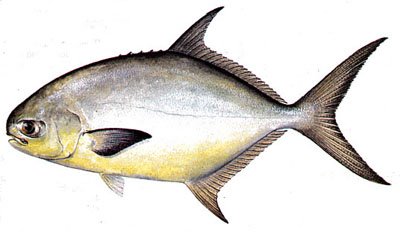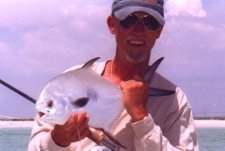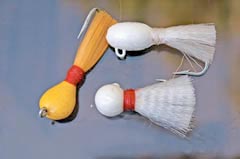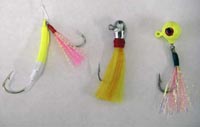Pompano Fishing Ever since the Florida voters decided by a 72% majority vote to amend our state constitution to eliminate gill nets in state waters, the inshore fishing has been improving. The first and most noticeable stock improvement was speckled trout. Almost immediately anglers began catching more and more trout in Tampa Bay and the surrounding waters of the ICW. Prior to the net ban, the gill nets were straining almost all the sea life out of our estuary on a daily basis. According to Ray Guess of the Florida Marine Patrol, now deceased, there were approximately 1,800 gill nets registered in Pinellas County in the late 70’s. When a license fee of $250.00 was implemented by the legislature in the early 80’s, the number dropped to 215 nets in Pinellas County. There remained a little over 200 nets licensed in the county up until the net ban took effect in 1996. The average length of the gill nets in our waters was 600 yards. There were many over 1,200 yards, even though it was illegal at the time to carry an over-sized net. If you do the math you can see that on any given day it was possible to have, with legal nets alone registered in Pinellas County, over 60 miles of gill nets in the water. Add Manatee and Hillsborough Counties’ nets and the miles more than triple. It was almost impossible for a decent sized trout, pompano, snook, redfish, mullet, or any other edible fish to escape the daily onslaught of the nets. Luckily, many of our estuarine species are fast growing and very prolific, so when the nets were removed from the water the numbers began to increase dramatically. We still have some poachers working throughout the state, but hopefully they will be caught soon and removed from our waters.
Bridge pilings are another great place to fish for them, where the barnacles have built up over the years and there are a lot of small crabs, shrimp and other shellfish living among the barnacle growth. (When fishing these areas, it doesn’t hurt to use a shovel or hoe to scrape the barnacles off the pilings to create a great chum line. You’ll be surprised at what you will attract in this manner.) Other places to hunt for pompano are around the mouths of passes, particularly those with a drop off or shell bottom near the mouth of the pass. Pass-a-Grill Pass is the prime example in our area, with a large, shallow sandy spoil outside the pass dropping off 18 feet to a hard shell bottom just inside the pass. This is an ideal spot to fish an incoming tide since the pompano and other game fish will be in the deeper water waiting for the tide to wash sand fleas, crabs, and other tasty morsels over the ledge to their waiting mouths. On the outgoing tide you can frequently find the pompano on the top of the spoils rooting around for sand fleas etc. The right tackle for pompano is a 6 to 8 pound spinning rig. Ten pound tackle is OK, but you lose a lot of the action with the heavier rod. Several baits work for pompano, including sand fleas, (live are best but frozen will work if fresh) fiddler crabs, and bloodworms. Some of you may have another bait or two that you use, but these are the basics. Fish them on the bottom with a weight small enough to hold them down but not so big as to hinder the movement along the bottom with the current. Pompano are always moving along the beaches looking for a meal being swept along with the wave action. The bag and size limit changes occasionally, so be sure to check them before you go fishing (click here) Capt. Charlie Walker |
Florida Saltwater Fishing in the Gulf of Mexico


 Our Florida regulations take that into effect and so do not allow the sale of any pompano over 20 inches. Since pompano do not generally grow over 20 inches, this eliminates the sale of permit, mis-represented as pompano. The pompano population is returning so fast that many younger anglers think that we have a new species suddenly in the Tampa Bay area. In fact, pompano were simply netted so efficiently prior to the ban that virtually no one but the commercial netters and the fish houses ever saw a pompano.
Our Florida regulations take that into effect and so do not allow the sale of any pompano over 20 inches. Since pompano do not generally grow over 20 inches, this eliminates the sale of permit, mis-represented as pompano. The pompano population is returning so fast that many younger anglers think that we have a new species suddenly in the Tampa Bay area. In fact, pompano were simply netted so efficiently prior to the ban that virtually no one but the commercial netters and the fish houses ever saw a pompano.  Walking the beaches and casting jigs into the surf is another method of fishing for pompano. If you find a spot of beach with a lot of sand fleas then you know that it is a good spot for pompano. Try it for a while and if nothing happens keep moving. Just be sure to remember where you found the biggest concentrations of sand fleas because the pompano might be there tomorrow. As for jigs, the old stand-by is a ¼ to ½ ounce yellow or white bullet-headed jig wrapped with the same color hair cut off at the bend of the hook. There are other jig patterns that will work because technique is the key when using jigs. In our area one local jig company makes “Doc’s Goofy Jigs” and they are dynamite on pompano and permit. You want to bounce the jig on the bottom so that when it falls a
Walking the beaches and casting jigs into the surf is another method of fishing for pompano. If you find a spot of beach with a lot of sand fleas then you know that it is a good spot for pompano. Try it for a while and if nothing happens keep moving. Just be sure to remember where you found the biggest concentrations of sand fleas because the pompano might be there tomorrow. As for jigs, the old stand-by is a ¼ to ½ ounce yellow or white bullet-headed jig wrapped with the same color hair cut off at the bend of the hook. There are other jig patterns that will work because technique is the key when using jigs. In our area one local jig company makes “Doc’s Goofy Jigs” and they are dynamite on pompano and permit. You want to bounce the jig on the bottom so that when it falls a puff of sand pops up that looks like a crab trying to bury itself. This will trigger a strike from any hungry pompano in the area. Just be sure when using a hair type jig that you cut off the hair at the bend of the hook. Pompano are notorious short strikers. Our pompano are growing up to be two to three pounds now and they can really give you a good scrap on light tackle. Try a few of these techniques and you will soon become addicted to pompano fishing and eating broiled, stuffed, grilled, baked, or fried fresh pompano every week.
puff of sand pops up that looks like a crab trying to bury itself. This will trigger a strike from any hungry pompano in the area. Just be sure when using a hair type jig that you cut off the hair at the bend of the hook. Pompano are notorious short strikers. Our pompano are growing up to be two to three pounds now and they can really give you a good scrap on light tackle. Try a few of these techniques and you will soon become addicted to pompano fishing and eating broiled, stuffed, grilled, baked, or fried fresh pompano every week.

